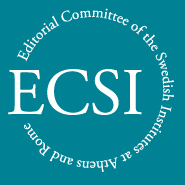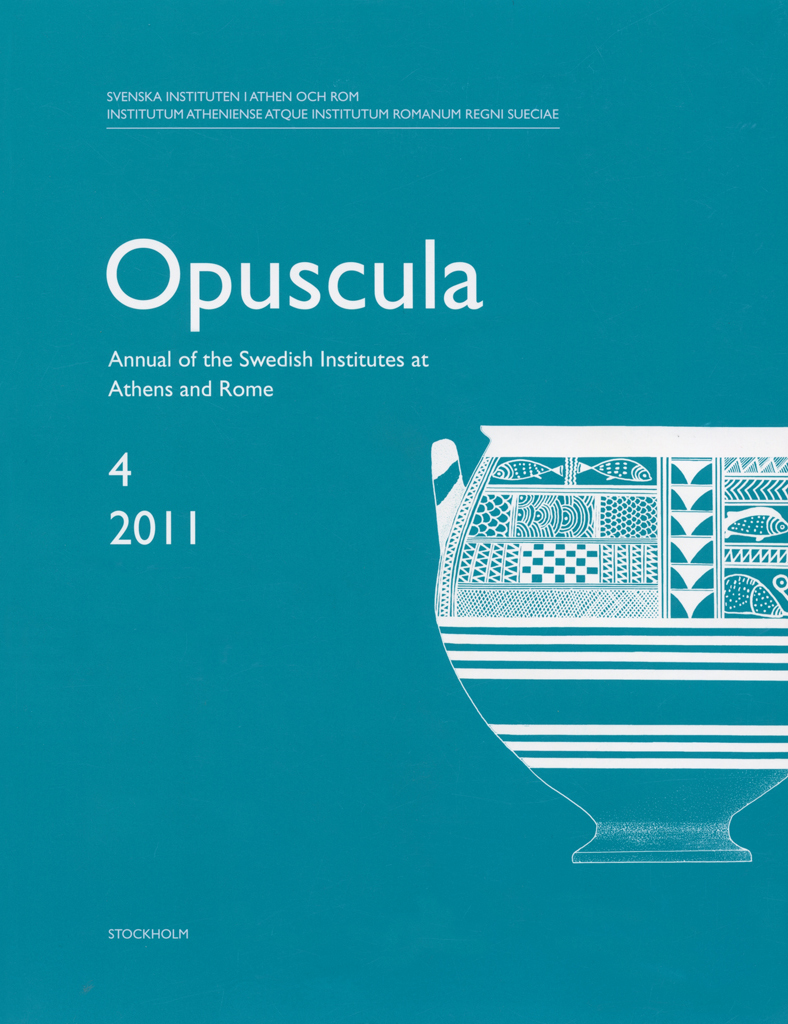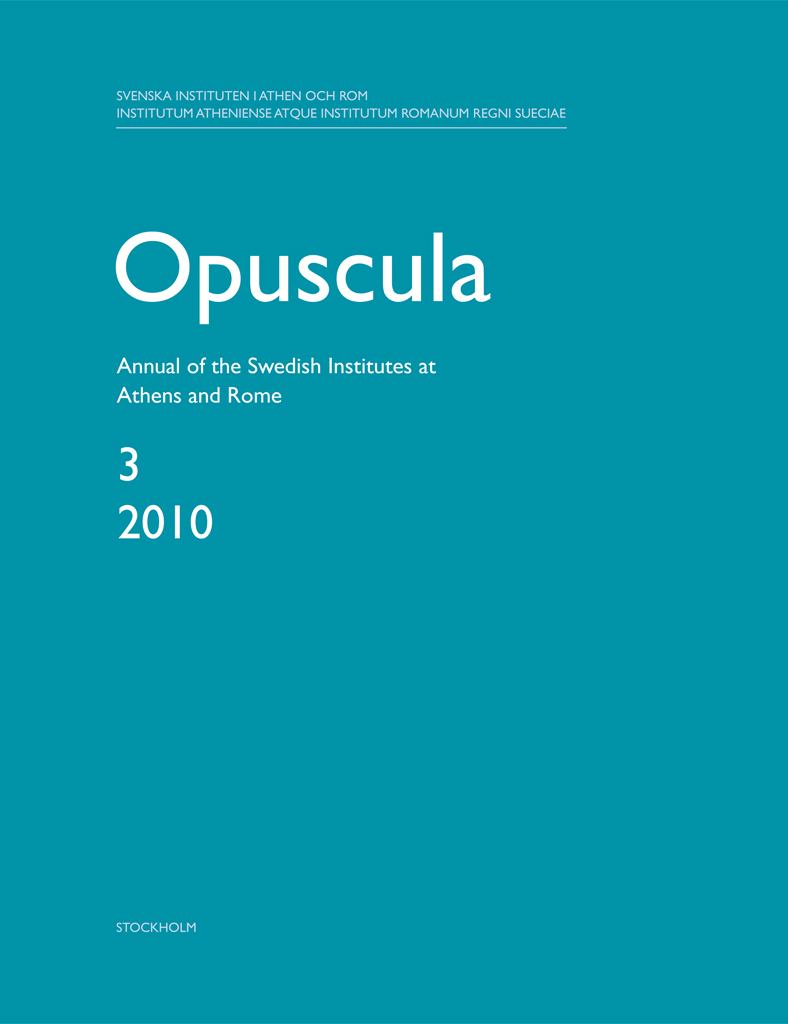Opuscula is published by the Swedish Institutes at Athens and Rome, with the aid of a grant from the Swedish Research Council. Distributed by Eddy.se AB. View journal at ERIH PLUS. All content available with open access. Book reviews Susanne Berndt-Ersöz | M. Xagorari-Gleissner, Meter Theon: Die Göttermutter bei den Griechen (Peleus Studien zur Archäologie und Geschichte Griechenlands und Zypern, 40), Ruhpolding: Verlag Franz Philipp Rutzen 2008. 161 pp., 14 pls. ISBN: 3-938646-26-7. https://doi.org/10.30549/opathrom-04-08 Hans Lejdegård | Ralph W. Mathisen & Danuta Shanzer (eds.), Romans, Barbarians, and the Transformation of the Roman World. Cultural Interaction and the Creation of Identity in Late Antiquity, Farnham: Ashgate 2011. 378 pp., 27 ills. ISBN: 978-0-7546-6814-5. https://doi.org/10.30549/opathrom-04-09 Karin W. Tikkanen | S. J. Harrison (ed.), Living Classics. Greece and Rome in Contemporary Poetry in English (Classical Presences), Oxford: Oxford University Press 2009. 346 pp., 1 fig. ISBN 978-0-19-923373-1. https://doi.org/10.30549/opathrom-04-10 Luciano Santella | B. Santillo Frizell, Lana, carne, latte. Paesaggi pastorali tra mito e realtà, Mauro Pagliai Editore, Firenze 2010, ISBN 978-88-564-0095-3. https://doi.org/10.30549/opathrom-04-11 Bibliographical information ‘Book reviews’, Opuscula. Annual of the Swedish Institutes at Athens and Rome (OpAthRom) 4, 159–168. Stockholm 2011. ISSN: 2000-0898 ISBN: 978-91-977798-3-8. Softcover, 168 pages.
Opuscula is published by the Swedish Institutes at Athens and Rome, with the aid of a grant from the Swedish Research Council. Distributed by Eddy.se AB. View journal at ERIH PLUS. All content available with open access. Italian dreams, Roman longings. Vilhelm Lundström and the first Swedish philological-archaeological course in Rome, 1909 By Anna Blennow & Frederick Whitling Abstract In Sweden, the future of Classical Philology and the study of the ancient past remain uncertain a century after the first Swedish university course in Rome, led by Vilhelm Lundström, Professor of Latin at Gothenburg, and the simultaneous establishment of the study of Classical Archaeology and Ancient History in Swedish academia in 1909. The institutionalisation of the Swedish scholarly presence in Rome materialised with the establishment of the Swedish Institute in Rome (SIR) in 1925, and its inauguration the following year—partly as a result of Lundström’s pioneering initiative. The present article discusses the implications of Lundström’s course in Rome as well as in Sweden, and sheds light on his neohumanist vision of an integrated study of antiquity; with Classical Archaeology and Ancient History as integral elements of Classical Philology. This vision lay abandoned throughout the twentieth century, but deserves to be…
Opuscula is published by the Swedish Institutes at Athens and Rome, with the aid of a grant from the Swedish Research Council. Distributed by Eddy.se AB. View journal at ERIH PLUS. All content available with open access. Is it possible to believe in a syncretistic god? A discussion on conceptual and contextual aspects of Hellenistic syncretism By Petra Pakkanen Abstract This article will look into the phenomenon of syncretism from two different points of view. Firstly, syncretism will be discussed from a conceptual perspective in relation to elaborations on belief, an equally perplexing concept in the studies of ancient Greek religion. Secondly, a very selective example of the syncretism between the goddess Demeter and Isis as an object of veneration in Ptolemaic Egypt will be looked at more closely in order to bring the conceptual perspective into closer contact with the contextual one. It will be argued that syncretism can be regarded both as an essence of polytheistic religious systems in particular, and as a process of syncretization. Once a metaphorical understanding of syncretism is added to these views, believing in a syncretistic deity (Demeter-Isis in our case) appears doubtful since a new entity in a polytheistic belief-system would have…
Opuscula is published by the Swedish Institutes at Athens and Rome, with the aid of a grant from the Swedish Research Council. Distributed by Eddy.se AB. View journal at ERIH PLUS. All content available with open access. Representing consulship. On the concept and meanings of the consular diptychs By Cecilia Olovsdotter Abstract Although the consular diptych does not appear as a distinct category of art until the end of the Roman consulate’s thousand-year history (c. 400–541), it constitutes a primary example of the continuance of Roman honorific tradition, developing concurrently with the division and transformation of the Roman empire and the resurgence of the consulate as the most prestigious office on the cursus honorum. By analysing and interpreting the patterns of motif selection, compositional structure and representational mode in the consular diptychs, it is possible to trace the various contextual factors, cultural and historical, that contributed towards their conception, and to gain valuable insights into the precepts of the late antique ‘ideology of consulship’ that was transmitted through this new visual medium. The present article discusses the different layers of meaning within the consular imagery, conveyed through an increasing elaboration and regularization of form and content, from the basic theme…
Opuscula is published by the Swedish Institutes at Athens and Rome, with the aid of a grant from the Swedish Research Council. Distributed by Eddy.se AB. View journal at ERIH PLUS. All content available with open access. The New Swedish Cyprus Expedition 2010. Excavations at Dromolaxia Vizatzia/Hala Sultan Tekke. Preliminary results. With appendices by P. Klingborg, F. and F. Kärfve, C. Hagberg, O. Svensson, S. Macheridis and L. Franz By Peter M. Fischer, with appendices by P. Klingborg, F. Kärfve, F. Kärfve, C. Hagberg, O. Svensson, S. Macheridis, L. Franz Abstract Determination of the complete occupational sequence of the site, including investigation of pre-12th century levels which were thoroughly studied by P. Åström since the 1970s, is the main task of the planned project. During the course of the expedition (NSCE11) in spring 2010 a ground-penetrating radar survey (GPR) was carried out at Dromolaxia Vizatzia/Hala Sultan Tekke in Area 6, leading to the discovery of a large Late Cypriote complex. The compound is bordered to the north by a substantial wall, against which nine rooms (so far) could be exposed. Two occupational phases have been verified but there are indications of a third. The suggested functions of the various structures…
Opuscula is published by the Swedish Institutes at Athens and Rome, with the aid of a grant from the Swedish Research Council. Distributed by Eddy.se AB. View journal at ERIH PLUS. All content available with open access. Labraunda 2010. A preliminary report on the Swedish excavations By Lars Karlsson, Jesper Blid & Olivier Henry Abstract The campaign of 2010 continued the work which was initiated last year. The excavations in the fortress on the Tepesar Hill were completed. The fortress consists of a large, early Hekatomnid tower where two black-gloss vessels indicated a dating of the tower to about 380–350 BC. In the two additions to the tower, several wellpreserved vessels dating from the 3rd century BC were uncovered. The latest fragment was a painted piece from a lagynos from around 200 BC, but there were no fragments of Megarian bowls. The test probe of last year in the West Church Complex was extended to a larger trench measuring c. 9 × 12 m. Evidence for three major phases could be established by J. Blid: (1) a Late Classical stoa; (2) the stoa colonnade is rebuilt into a Christian basilica of the 5th century AD; (3) a Middle Byzantine building…
Opuscula is published by the Swedish Institutes at Athens and Rome, with the aid of a grant from the Swedish Research Council. Distributed by Eddy.se AB. View journal at ERIH PLUS. All content available with open access. A courtyard gate at Thourioi By Henrik Gerding Abstract In the early seventies Paola Zancani Montuoro suggested that a large paved structure, which had recently been uncovered at the site of Sybaris/Thourioi in southern Italy, was the remains of an ancient neosoikos, or shipshed. This idea quickly gained widespread acceptance and is still often repeated, despite some objections having been raised. In this paper it is argued that the structure, which cannot have been a shipshed, was actually a courtyard gate belonging to the Late Classical or Early Hellenistic city wall of Thourioi. Bibliographical information Henrik Gerding, ‘A courtyard gate at Thourioi’, Opuscula. Annual of the Swedish Institutes at Athens and Rome (OpAthRom) 4, 7–18. Stockholm 2011. ISSN: 2000-0898 ISBN: 978-91-977798-3-8. Softcover, 168 pages. https://doi.org/10.30549/opathrom-04-02
Opuscula is published by the Swedish Institutes at Athens and Rome, with the aid of a grant from the Swedish Research Council. Distributed by Eddy.se AB. View journal at ERIH PLUS. Content available with open access. Book reviews Eva Rystedt | S. Langdon, Art and identity in Dark Age Greece, 1100–700 B.C.E., Cambridge University Press 2008. 388 pp., 119 ills. (black-and-white photos), 4 tables. ISBN 978-0-521-51321-0. https://doi.org/10.30549/opathrom-03-10 Eva Rystedt | V. Karageorghis, A lifetime in the archaeology of Cyprus. The memoirs of Vassos Karageorghis, Stockholm: Medelhavsmuseet 2007. xvi + 226 pp., 187 figs. ISBN 91-89242-14-9. https://doi.org/10.30549/opathrom-03-11 Bibliographical information ‘Book reviews’, Opuscula. Annual of the Swedish Institutes at Athens and Rome (OpAthRom) 3, 219–224. Stockholm 2010. ISSN: 2000-0898. ISBN: 978-91-977798-2-1. Softcover, 224 pages.
Opuscula is published by the Swedish Institutes at Athens and Rome, with the aid of a grant from the Swedish Research Council. Distributed by Eddy.se AB. View journal at ERIH PLUS. Content available with open access. Pictures and people. Seals, figurines and Peloponnesian imagery By Erika Weiberg Abstract The point of departure for this paper is the publication of two Early Helladic sealing fragments from the coastal settlement of Asine on the north-east Peloponnese in Greece. After an initial description and discussion they are set in the context of sealing custom established on the Greek mainland around 2500 BCE. In the first part of the paper focus is on the apparent qualitative differences between the available seals and the contemporary seal impressions, as well as between different sealing assemblages on northeastern Peloponnese. This geographical emphasis is carried into the second part of the paper which is a review and contextualisation of the representational art of the Aegean Early Bronze Age in general, and northeastern Peloponnese in particular. Seal motifs and figurines are the main media for Early Helladic representational art preserved until today, yet in many ways very dissimilar. These opposites are explored in order to begin to build a…
Opuscula is published by the Swedish Institutes at Athens and Rome, with the aid of a grant from the Swedish Research Council. Distributed by Eddy.se AB. View journal at ERIH PLUS. Content available with open access. Chiusi e il Clusium Group. Un nuovo documento dagli scavi di Orvieto By Fernando Gilotta Abstract This note deals with sherds of a very important “new” Etruscan red-figure cup from Orvieto (Excavations Campo della Fiera, 2006), showing a fragmentary group of Fufluns/Satyr and a winged female goddess. The poorly preserved paintings, close to the “Clusium Group” as far as the central medaillon is concerned, are reminiscent of older “tiberine” vases, such as the Casuccini stamnos and related pottery, and at the same time show intriguing links with later Faliscan and Campanizing red-figure. This combination of stylistic and workshop relationships sheds light on the milieu from which the Clusium Group (possibly) emerged around the middle of the fourth century BC. As for the kylix, a date toward the third quarter of the fourth century BC is suggested. Bibliographical information Fernando Gilotta, ‘Chiusi e il Clusium Group. Un nuovo documento dagli scavi di Orvieto’, Opuscula. Annual of the Swedish Institutes at Athens and Rome (OpAthRom) 3,…


